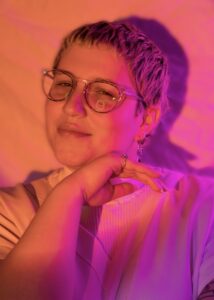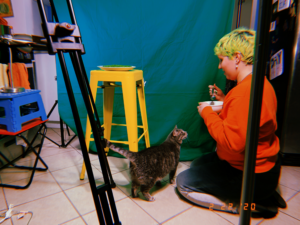Taking Pride In Being Different: Reflecting on Being Non-Binary and Autistic
by Blog Writers
by Liz Johnson.
I knew I was non-binary before I knew I was autistic. But neither were surprising to me, truthfully.
I am not the first, and I’m certainly not the last, to be at this intersection of identity.
Research from a 2020 study cites gender-diverse people are three to six times more likely to be autistic than those that are cisgender.
Before I even knew I was trans or autistic, I knew myself to be strange – both because other kids called me that, and because it was one of those lingering suspicions. But I owned that early, befriending fellow playground weirdos and saying “thank you” anytime another child would bestow the word “weird” upon me in an insult. I had an understanding that being a little odd would always feel more comfortable to me than changing parts of myself that I cherished to fit an expectation of normalcy. As I got older, this internal acceptance of difference, though sometimes hard-fought, made it easy to interrogate, accept, and love my non-binary identity. Early on, I understood the expectation of heteronormativity – the societal expectation to be heterosexual as the standard – already having come out as bisexual at thirteen. It was no shock the same normative standard would apply to gender.
I remember feeling like, as much as I experimented with clothing, I wasn’t getting the gender euphoria I wanted. The absolute joy I got when people saw me as my full self in other facets just wasn’t clicking when it came to my gender. Long curly hair, a girlish nickname, and she/her pronouns just weren’t feeling suited to me – like a sweater I could admire on somebody else but fit me all wrong. Research being a favorite dual purpose coping mechanism/hobby of mine, and human psychology and sexuality being an intersection of special interest, I dove into researching why I felt the way I did about gender. A deep dive through the internet, combing through explanatory breakdowns of queer theory, to expansive lists of gender identity labels, left me to land on simply identifying as the label I felt suited me best – non-binary. I had friends who were having a lot of the same feelings. When I shared this identity with them first at seventeen – asking them to use my new name, use gender neutral pronouns – it was a safe way for me to confirm that being non-binary feels like home to me. I was lucky to have a supportive family as well, being surrounded by a community that supported and affirmed me, I could truly be myself. I think this identity and my relationship to it has grown with time. As I get to know myself better, I live in it more fully. It was the right fit then and it is the right fit now.
I was diagnosed with Autism Spectrum Disorder just this year, at twenty-six. I got here after similarly winding rabbit holes of research and a steady influx of my community support. I’m still settling into it all, but it definitely made so much of my life make more sense – in a lot of the same ways finding the words for my gender did. But beyond that, understanding how some of the idiosyncrasies of my mind worked was such a relief. I already had a diagnosis of ADHD given at twenty-one, so neurodiversity isn’t a stranger to me. In fact, across my circles of friends, most of my friends were neurodivergent anyway in the same way that a lot of my friends are queer and trans too. We tend to find each other somehow! My autistic friends were intrinsic to helping me understand myself as an autistic person in addition to having ADHD. Again, being a sounding board for my feelings just as the times in my teens when I had been processing my gender. My family showed up again in a new way, some of them asking the same questions about behaviors and feelings they had day-to-day, eagerly awaiting my assessment results. I was happy to be the person that could deliver the news that I was autistic, and start conversations on what that not only looked like for me, but be a support for my loved ones wondering what it looks like for them.
Access to the information to get the understanding of myself has come from a combined force of my support system, wider community of people who share my identities, and the internet as a whole. Looking back, it was vastly easier to uncover and affirm my gender identity than it was to gain an autism diagnosis. People assigned female at birth have a harder time getting diagnosed. “A fundamental issue with the current diagnostic methods is that the behavioral markers used as criteria are established on pre-existing conceptions of what autistic behaviors look like. These criteria have been developed based on the predominantly white male populations previously identified as autistic” (Hull et al. 2020). Not every person’s experience of autism will look the same. I mask highly, and the way I stim with finger tapping and knee-bouncing, just as an example, can be overlooked as a stimming behavior. I’m learning more about how I can feel at home as an autistic individual, and the autistic community around me is instrumental in that.
There is an intersection of queerness that aligns with one of the great strengths of neurodiversity. Both communities value questioning normative standards and challenging the societal expectations put on us. The kind of weirdness I’ve always felt for being different than the expectation is not only understood by trans and autistic people alike but, more often than not, celebrated by both. I celebrate it, too. Neurodiversity manifests in many ways as does gender diversity. No one individual’s experience with gender, nor being autistic, will be exactly the same. Existing on the spectrums of both empowers me to be my fullest and truest self, and I’m inspired by all the people who join me at this intersection.
Liz is a queer & disabled writer, filmmaker, and multimedia artist. They are a Columbia College Chicago graduate and current freelancer with a broad portfolio, and pride themselves on being a jack-of-all-trades (and master of a few).










June 22nd, 2023 at 2:47 am
This thought-full and clearly stated glimpse into the intersections of your life feels like a beam of sunlight, both enlightening and heart-warming. Likely your research has made obvious the essential value of the collective insight, wisdom, and guidance from individuals who traverse the intersections. Without it, we know very little. We need your light; thank you for shining it.